

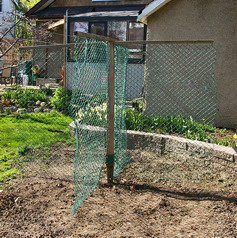
Last Thursday morning the long forgotten sun came out and the temperature rose to the point that I took off my parka and stood on the back deck. I stood there for quite some time mesmerized. I had spent so little time in the, cold, rain soaked garden that I was weeks behind my normal schedule and I couldn’t decide what to do first. It was past time to be writing this issue of Dallying In The Dirt but it would have to wait. I write about what I’m doing in the garden and I hadn’t been doing anything. Let’s prioritize. The plants in the cold frame and under the lights were actually growing. It was too cold to release the the nematodes. Many packages of seeds were sitting in the seed box doing nothing and I can’t remember the last time that the Peas weren’t in the ground in April. Of course it wasn’t as simple as just planting a few seeds. The ground had to be prepared. Despite the cold and wet a significant quantity of natural vegetation, (aka. Weeds,) had managed to cover the bare soil and that soil was just starting to be dry enough to work with. An hour or two with the hoe and the weeds were gone and the soil was slightly broken up, just enough, that it could dry out a little quicker. The pea seeds were found and put in some water to soak. The Peas structures were erected and finally those peas were nestled into the cool damp soil. This was quickly followed by the Carrots and Beets. 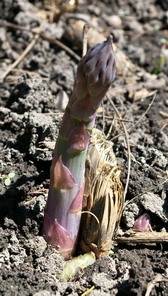 We have eaten the Asparagus about four time by now as it has managed to grow, a bit slowly, through the cold wet soil. It is already getting hard to find because my two most prolific weeds, Garlic seedlings and Forget Me Nots are thriving in the Asparagus beds. Two useful plants that can escape and become a real nuisance. Have managed to start that weeding process but they seem to grow faster than I can hoe.
We have eaten the Asparagus about four time by now as it has managed to grow, a bit slowly, through the cold wet soil. It is already getting hard to find because my two most prolific weeds, Garlic seedlings and Forget Me Nots are thriving in the Asparagus beds. Two useful plants that can escape and become a real nuisance. Have managed to start that weeding process but they seem to grow faster than I can hoe. 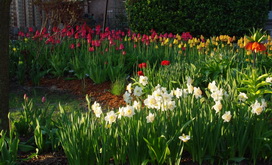 I need to spend more time than usual in the front garden where hundreds of bulbs are approaching perfection. A magazine is coming to do a photo shoot of those gardens and that has me out there weeding and transplanting and freshening up the mulch. We kept delaying the actual shoot day as the cold wet weather keeps the Tulips from providing the glorious colour that we need for the photos. Here is a peek at what they found on Monday.
I need to spend more time than usual in the front garden where hundreds of bulbs are approaching perfection. A magazine is coming to do a photo shoot of those gardens and that has me out there weeding and transplanting and freshening up the mulch. We kept delaying the actual shoot day as the cold wet weather keeps the Tulips from providing the glorious colour that we need for the photos. Here is a peek at what they found on Monday.Since that first sun on Thursday there has been a wonderful succession of warm sunny days. Friday was spent at Loblaw’s media day where we were wined, dined and regaled with all of the wonderful new plants that they are going to have in their garden centres by next week. I will tell you more about what I saw that, at least to me, is worth giving garden space to in the next issue of Dallying that hopefully will be along in about a week as I slowly get caught up, (does that actually ever happen???) in the garden. I’m always fascinated that this large grocery chain spends a considerable amount of time and effort making their temporary garden centres such worthwhile places to visit. Most big box stores just pull up a truck load of the cheapest annuals they can find but these people are serious gardeners that look for new and interesting plants and that run the greatest pot recycling program in this country. Now I have to find locations in the garden for all of the sample plants that we brought home. 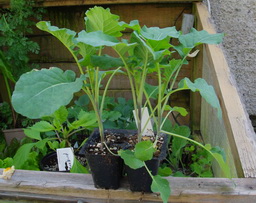 By this morning, all of the seeds that need to be in the garden are there. The Broccoli, Cauliflower and Brussels Sprouts are still growing nicely in the cold frame and should be moving out later today. I needed to weed and cultivate a bit more of the garden and the further south I get into that soil, the wetter it is, so I had to wait for a few more sunny days.
By this morning, all of the seeds that need to be in the garden are there. The Broccoli, Cauliflower and Brussels Sprouts are still growing nicely in the cold frame and should be moving out later today. I needed to weed and cultivate a bit more of the garden and the further south I get into that soil, the wetter it is, so I had to wait for a few more sunny days.
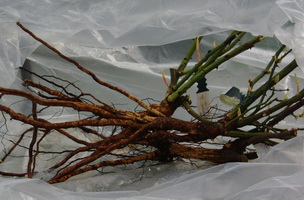 Into the middle of this mad rush to get caught up, a large cardboard box arrived. The name was emblazoned on the side and I got quite excited. Opened it very carefully to find three new David Austin Roses. They were large bare root plants that required fairly immediate attention. I kept them cool and damp in their plastic bag until I could figure out the best place to plant them. A little research on David Austin’s web site to find out exactly what I had, helped with choosing their locations. It makes no sense to put a Rose bush that is going to grow to 1.3 M in a space that only has room for a plant half that size. I also don’t want some sharp thorny branches overhanging a frequently used path. They did get planted and that’s not a five minute job. They have large roots and in this climate we have to plant them deep enough to bury the bud union so that they will survive the winter. Interestingly, two of them were growing on their own roots which should make much better and hardier bushes. We now wait for midsummer to see just how they perform. You will get updates.
Into the middle of this mad rush to get caught up, a large cardboard box arrived. The name was emblazoned on the side and I got quite excited. Opened it very carefully to find three new David Austin Roses. They were large bare root plants that required fairly immediate attention. I kept them cool and damp in their plastic bag until I could figure out the best place to plant them. A little research on David Austin’s web site to find out exactly what I had, helped with choosing their locations. It makes no sense to put a Rose bush that is going to grow to 1.3 M in a space that only has room for a plant half that size. I also don’t want some sharp thorny branches overhanging a frequently used path. They did get planted and that’s not a five minute job. They have large roots and in this climate we have to plant them deep enough to bury the bud union so that they will survive the winter. Interestingly, two of them were growing on their own roots which should make much better and hardier bushes. We now wait for midsummer to see just how they perform. You will get updates.Time to answer a few questions and then get back into the garden. If you have a gardening question just ‘reply’ to this newsletter and send me your query. I try to answer most of the questions and the ones that I answer here are those that I think will have the widest interest. You can also find the latest garden updates on the front page of gardening-enjoyed . Joachim Asks? Last year I used fine cedar mulch (including the bigger bits that were in the bags) from Sheridan to do all my perennial flower beds, and it certainly made a difference in the amount of watering needed. However, this spring how do I go about adding compost? Can I just add it on top of the mulch. |
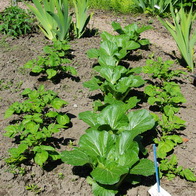 It was time to take a short breath and do a little planning. Where should the other early vegetables go. Crop rotation is a bit of a joke in a garden area as small as most backyards. Diseases and bugs that crop rotation is supposed to be hiding from, can easily find their hosts in the area that we have to work with. Nonetheless I do try, to not put the vegetables, back into the exact same spot where they grew last year. Besides I just like to see how I can make the garden look different each year and to discover what works well with what. The
It was time to take a short breath and do a little planning. Where should the other early vegetables go. Crop rotation is a bit of a joke in a garden area as small as most backyards. Diseases and bugs that crop rotation is supposed to be hiding from, can easily find their hosts in the area that we have to work with. Nonetheless I do try, to not put the vegetables, back into the exact same spot where they grew last year. Besides I just like to see how I can make the garden look different each year and to discover what works well with what. The 